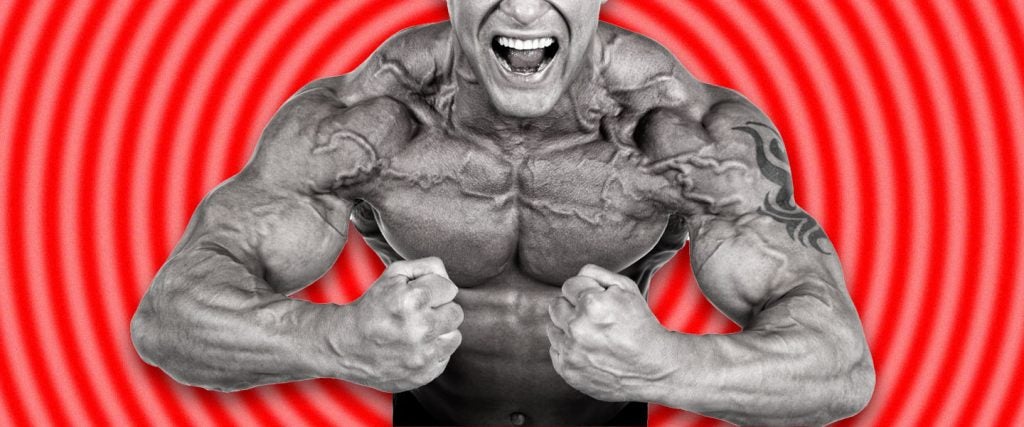Much has been alleged about the superhuman strength that’s swelled within the limbs of ordinary people when they’ve been faced with mortal threats or other dire circumstances. The typical version of the story will involve a father who miraculously experienced a surge of adrenaline so potent that he was able to lift a car clean off the ground and rescue his child from certain death. And yet, even in the era of the ubiquitous smartphone, such feats have always managed to escape capture on video, thereby shading references to their occurrence with an assumption of dubiousness.
Real or not, though, many people wonder what kind of power adrenaline brings with it — namely, can it provide you with a Herculean level of pillar-shifting might?
Yeah, will it turn me into Hercules — or even better, the Incredible Hulk?
First thing first, let’s consider the actual reported details of what many regard to be the original parent-lifts-a-car-to-save-their-child story. The Associated Press reported in April 1982 that Tony Cavallo was busy working beneath his 1964 Chevy Impala “when the bumper jack slipped out and the car fell on him, knocking him out.” From there, Cavallo’s fiftysomething mother Angela rushed out and lifted the car’s chassis four inches while kicking her son and trying to get him to move. When he still didn’t budge, a young neighbor boy named ran to fetch two other neighbors, who reinserted the jack and pulled Cavallo to safety, with Angela holding the chassis the whole time.
Angela attributed her unprecedented feat to the continuous prayer she uttered while keeping the Impala aloft. Acts of God notwithstanding, there’s simply too much we don’t know about what transpired that evening to credit Angela Cavallo with lifting a 3,300-pound car four inches off-the-ground. But if you’re the gambling type, all of the smart-money bets would be wagered against the likelihood of it happening.
For starters, given that the 1964 Impala is possibly the most frequently customized car in history with respect to it being fitted for hydraulics, was Angela merely elevating one corner of an Impala with activated hydraulics, which would have been fully capable of being driven with three wheels on the ground at a time? In fact, depending on hydraulic engagement, Angela potentially could have raised one corner of a loosened Impala chassis four inches into the air while none of the car’s wheels ever left the ground.
In other words, Angela was probably only lifting a couple hundred pounds instead of thousands. This is still an impressive feat for a woman of her relatively advanced age, but let’s not reimagine the event as if she pulled a Wonder Woman.
Fair enough, but how does adrenaline even work?
Adrenaline is a physical response brought about by the presence of a threat, intense stress or extreme excitement. When these situations occur, your medulla — contained within your adrenal glands — pumps adrenaline into your blood. In response to the presence of adrenaline, your air passages dilate in order to provide your muscles with increased oxygen. At the same time, your blood vessels contract to pump larger than normal quantities of blood to the major muscle groups that are being prepped to take drastic actions along fight-or-flight lines.
This provides the recipients of adrenaline surges with the dual advantages of extraordinary strength and reduced sensitivity to pain. Adrenaline is therefore credited in situations where people have been shot or stabbed and have still been able to flee or effectively overcome their attackers, and is also the only logical explanation for nearly every Hulk Hogan victory between 1984 and 1990.
How strong can adrenaline actually make me?
It’s impossible (and unethical) to replicate true life-or-death situations with human beings in laboratory settings, so there are inherent limitations to the testing of adrenaline’s potential to initiate a display of otherworldly strength.
That said, as fun as it would be to think that a diminutive, 120-pound non-athlete could suddenly summon up the strength to take down every highly trained starter on the high school wrestling team, the laws of physics still operate even when adrenaline is involved. This means that untrained muscles, ligaments and tendons will be ill-equipped to lift weights that are well outside of the realm of physical possibilities, unless the blood coursing through their veins also happens to have been laced with radioactive properties.
All of which is to say, adrenaline might enable your body to extract a 100-percent effort out of its current constituent parts, but attempting physical feats beyond its capabilities is going to result in the tearing or breaking of anatomical parts.
You can probably gauge the pinnacle of adrenaline’s real-world potential by evaluating the peak performances of trained athletes on the grandest stages. Adrenaline is certainly a factor in amplifying feats of speed, strength and endurance during such momentous events, and it’s unlikely that any world records would be broken in these moments if it weren’t for the invigorating presence of adrenaline. But again, these are instances in which adrenaline, training and preparation merge to make magic happen. If you think you’re going to be able to karate chop a seven-inch support beam in half to save your friend simply because adrenaline has taken control of your body, I’ve got a lovely ski resort in Okinawa to sell you.

